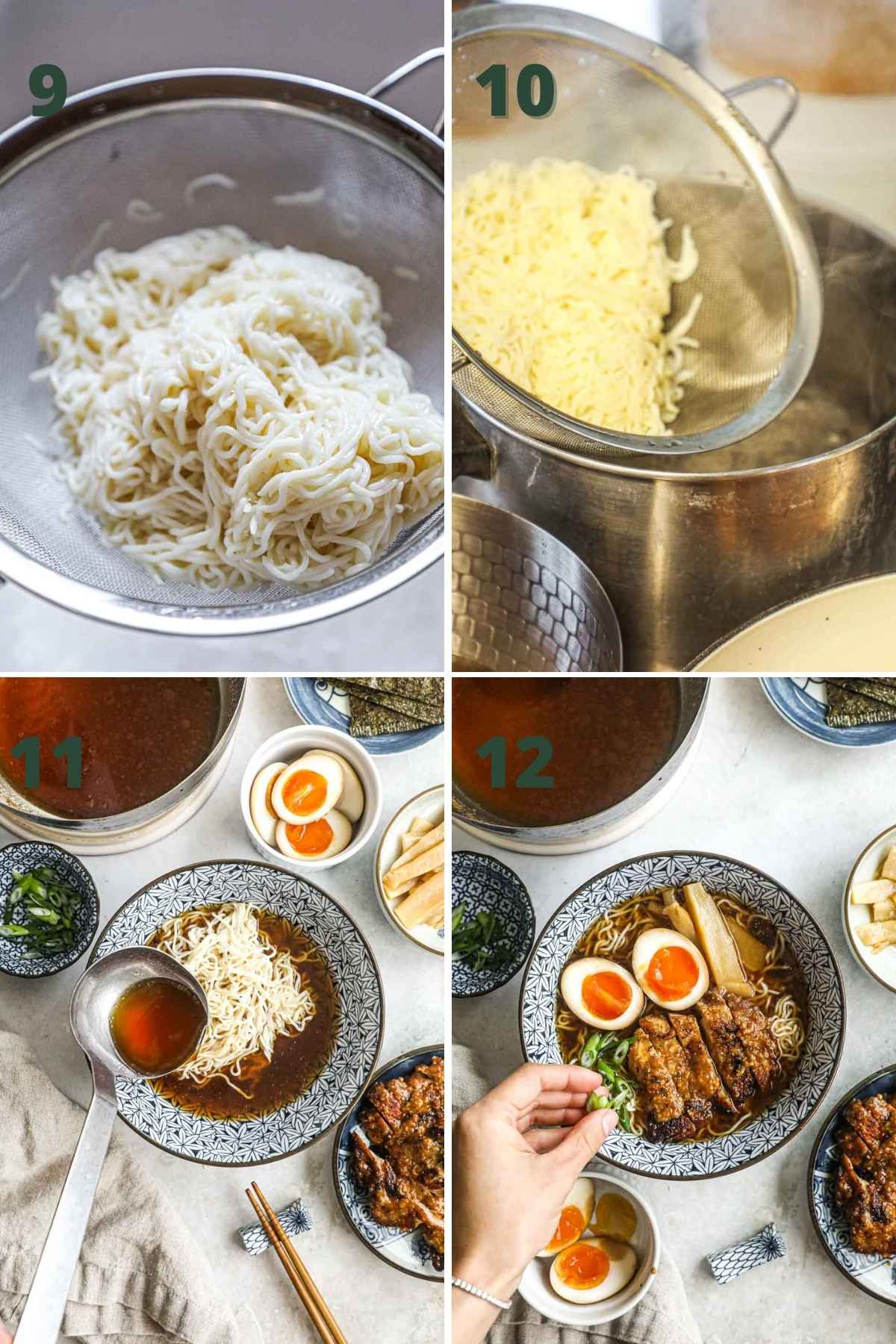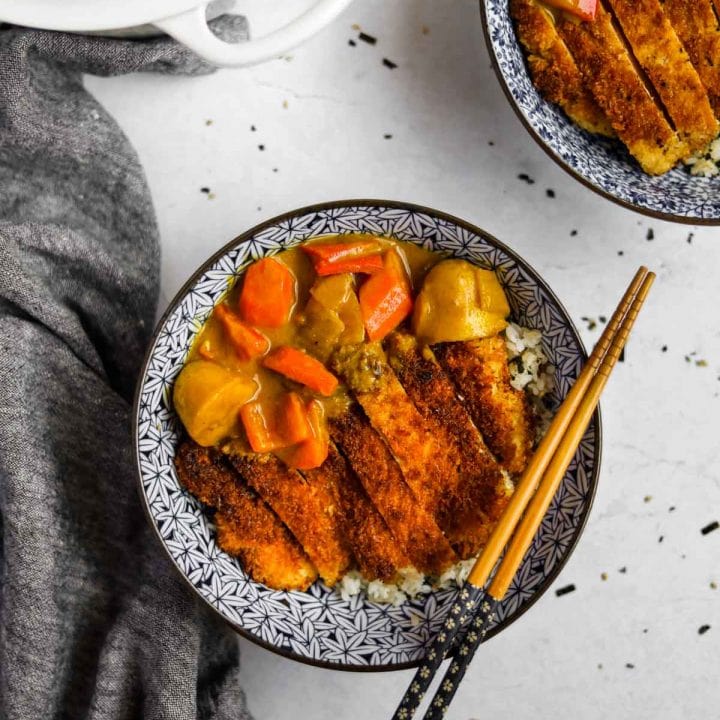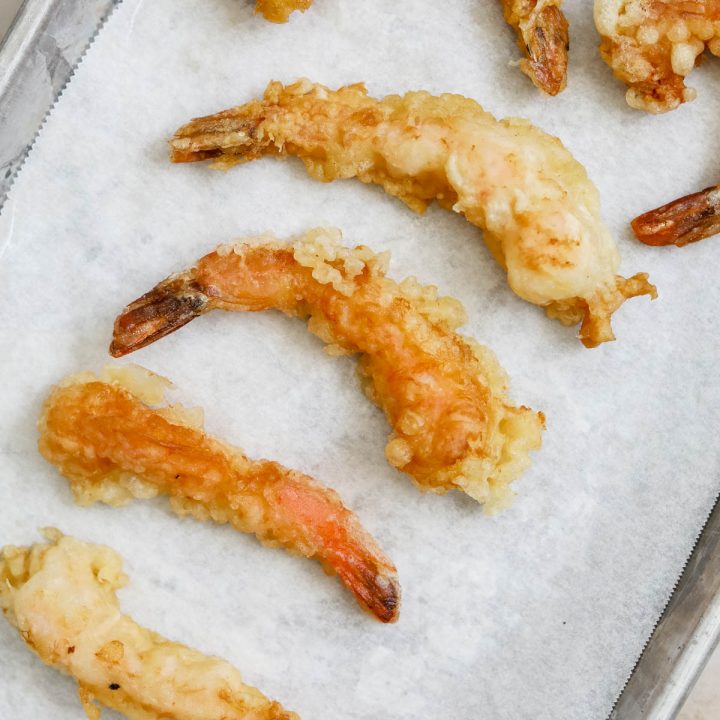Gluten-Free Ramen with Miso Chicken is a flavor-packed Japanese noodle soup you will not believe is gluten-free! It features juicy miso chicken, gluten-free noodles, marinated ramen eggs, and your favorite ramen toppings. Learn how to make this restaurant quality ramen in just a few simple steps!

Don't be intimidated, this gluten-free ramen is easier to make than it looks and makes the perfect cozy weeknight dinner. It is also great for those with celiac disease or gut issues since it is gluten-free with simple unprocessed ingredients.
Jump to:
About Gluten Free Ramen
- Taste - The noodles, chicken, and toppings create a delicious combination of umami flavors.
- Texture - The broth is thick, the chicken is juicy, and the noodles and egg are firm.
- Effort - All you need to do is cook the chicken and eggs then the ramen noodles. If you want to streamline the process, make the eggs the night before.
- Time - It takes about 10 minutes to prep the ingredients, 20 minutes to cook the chicken and eggs, and about 5 minutes to cook the ramen and assemble it.
What is Ramen?
Ramen is a popular Japanese soup dish that consists of broth, noodles, and toppings. Our favorite type of ramen is miso ramen. But there are tons of other delicious types. Some other popular types of ramen include shio (salt), shoyu (soy sauce), and tonkatsu (pork bone) ramen. We love to mix and match these different ramen broths with noodles and toppings to make new flavor combinations!
Ingredients


- Shirataki gluten free noodles - We love the flavor and texture of these thin gluten free noodles.
- Miso Jidori chicken - Miso chicken adds a delicious umami flavored protein to the ramen.
Toppings
- Ajitama ramen eggs or soft boiled jammy eggs - Ajitama have a soft buttery yolk and almost teriyaki-like flavor. If you don't have time to make our ajitama recipe, soft boiled jammy eggs are also delicious in this recipe.
- Menma- Menma are marinated sliced bamboo shoots.
- Scallions - Scallions add an aromatic crunch.
- Nori - Nori is dried Japanese seaweed. It adds extra flavor and texture.
See recipe card for quantities.
Substitutions
- Char siu - Char siu is roasted pork shoulder and makes a rich addition to the ramen.
- Fried pork belly - Fried pork belly is a rich cut of pork with a crispy texture.
- Gluten free noodles - You can swap shirataki gluten free noodles for rice noodles and other gluten free noodles.
- Non-gluten free - This recipe will also be delicious with regular wheat noodles and regular shoyu.
Variations
- Shrimp tempura - Shrimp tempura are crispy fried shrimp and make a scrumptious addition to ramen.
- Corn - Add corn for a sweet accent.
- Blanched bean sprouts - Bean sprouts add a nice light crunch.
- Chicken stock - You can use chicken broth instead of water to make the dashi for a richer and heartier broth.
Instructions

Miso Chicken
- Mix sauce - Add white miso paste, sake, mirin, and gluten free soy sauce or tamari in a mixing bowl and whisk until smooth. Set aside. (Photo 1)
- Season chicken - Dry the chicken thighs with a paper towel and season generously on both sides with kosher salt, pepper, and garlic powder. (Photo 2 and 3)
- Cook chicken - In a large skillet over medium heat, add oil. Once the oil is hot, use tongs to place the chicken skin side down. Use the tongs to gently push down on the meat so all of the skin comes into contact with the pan and cooks evenly. Cook undisturbed for 5-7 minutes until the fat renders and the skin turns golden. (Photo 4)

- Cook chicken through - Then turn the chicken thighs over and cook for an additional 8-10 minutes or until the internal temperature reaches 165°F in the thickest part. (Photo 5)
- Simmer in sauce - Reduce the heat to low, then pour the miso sauce in the pan over the chicken, using tongs to lift the chicken and nestle it into the sauce. Be careful to not get too much of the sauce on the skin. Cook for an additional 2 minutes to reduce the sauce, baste the chicken with the sauce, then remove from heat. (Photo 6)
- Cut chicken - Place the chicken on a cutting board and slice into strips. Sprinkle with sesame seeds and set aside. (Photo 7)
Ramen
- While the chicken cooks, start the ramen. Boil 2½ cups chicken stock in a medium pot. Add the dashi soup base and stir until dissolved. Turn off heat. (Photo 8)

- Rinse and cook noodles - Boil water in a medium pot. Drain and rinse tofu shirataki noodles thoroughly using a strainer. Add noodles and boil for 1 minute then drain. (Photo 9 and 10)
- Serve - Transfer noodles and divide broth into soup bowls. Top with miso chicken and ramen toppings. (Photo 11 and 12)
Pro tip - If using other gluten-free ramen noodles, you can skip rinsing the noodles.
What to Serve With Gluten-Free Ramen
This dish is very filling on its own but sometimes we also enjoy it with appetizers like this Tekka Maki or Japanese Cucumber Salad Recipe. If you are looking for a refreshing Japanese dessert, try our Strawberry Mochi or Japanese Fruit Sandwiches.
Storage
Refrigerate leftover gluten free ramen in separate air-tight containers for up to 3 days. To reheat the broth, transfer it into a pot and heat over low-medium heat, stirring occasionally. In order to reheat the chicken, microwave it or heat in a pan over low-medium heat until warm. Only assemble the ramen when you are ready to eat to prevent the noodles from getting soggy. Likewise, make sure the ingredients are stored separately so they don't get soggy while stored.
Cooking tips
- Be sure to dry off the chicken with paper towels to ensure the chicken will get crispy.
- Be careful to not overcook the noodles or they will become chewy. After 1 minute, they should be firm and done cooking.
- If you make ajitama, marinate the eggs the night before so the cooking process is smooth and efficient.
- Store leftover broth and noodles separately so they hold their shape and don't get soggy.
Recipe FAQs
Most ramen is made with wheat noodles. Certain ramen broths also contain soy sauce, which is not gluten free.
Yes, we use Shirataki gluten free noodles because they are thin yet perfectly firm. There are other gluten free brands as well.
Most ramen isn't super healthy due to the high sodium and low nutritional value of ramen noodles. However, our ramen is healthier because we use shirataki noodles and simple, unprocessed ingredients like nori, eggs, and miso chicken.
So many meats are delicious with ramen. We love chicken because it is healthy and protein-packed, but you can also use char siu (pork), fried pork belly, beef, or tofu.
The most important things are to have a flavorful broth and to not overcook the noodles. The noodles should be perfectly firm and not chewy.
The main traditional ingredients are broth, noodles, and various toppings. While toppings vary widely, some common ones include egg, char siu, and nori.
Related Recipes
Did You Like This Recipe?
Love this easy gluten free ramen recipe? Please leave a 5-star rating in the recipe card below & leave a comment below. Thanks!
Sign up for THP's newsletter and keep in touch on Instagram, Facebook, Pinterest, TikTok, and YouTube. If you make this simple buttered leeks recipe, tag #theheirloompantry so we can see your miso chicken ramen!
📖 Recipe
Gluten Free Ramen with Miso Chicken
Equipment
Ingredients
- Shirataki tofu gluten-free ramen noodles or gluten-free ramen noodles
- 2½ cups chicken or vegetable stock
- ¼ cup gluten-free shoyu tare store-bought concentrate or see notes for instructions
Miso Chicken
- 1½ tablespoon white miso paste
- 1 tablespoon sake
- 1 tablespoon mirin
- 1½ teaspoon gluten-free soy sauce or tamari
- 1 lb jidori or regular chicken thighs 2 boneless, skin-on thighs
- kosher salt
- freshly ground black pepper
- 1½ teaspoon garlic powder
- 1 tablespoon cooking oil
- sesame seeds optional
Toppings
- 2 ajitama ramen eggs or soft boiled jammy eggs sliced in half
- menma marinated sliced bamboo shoots
- scallion greens sliced
- 1 sheet nori cut into 4 pieces
Instructions
Miso Chicken
- Mix sauce - Add white miso paste, sake, mirin, and gluten free soy sauce or tamari in a mixing bowl and whisk until smooth. Set aside.1½ tablespoon white miso paste, 1 tablespoon sake, 1 tablespoon mirin, 1½ teaspoon gluten-free soy sauce or tamari
- Season chicken - Pat the chicken thighs dry with a paper towel and season generously on both sides with kosher salt, pepper, and garlic powder.1 lb jidori or regular chicken thighs, kosher salt, freshly ground black pepper, 1½ teaspoon garlic powder
- Cook chicken - In a large skillet over medium heat, add oil. Once the oil is hot, use tongs to place the chicken skin side down. Use the tongs to gently push down on the meat so all of the skin comes into contact with the pan and cooks evenly. Cook undisturbed for 5-7 minutes until the fat renders and the skin turns golden. Then turn the chicken thighs over and cook for an additional 8-10 minutes or until the internal temperature reaches 165°F in the thickest part.1 tablespoon cooking oil
- Simmer in sauce - Reduce the heat to low, then pour the miso sauce in the pan over the chicken, using tongs to lift the chicken and nestle it into the sauce. Be careful to not get too much of the sauce on the skin. Cook for an additional 2 minutes to reduce the sauce, baste the chicken with the sauce, then remove from heat.
- Cut chicken - Place the chicken on a cutting board and slice into strips. Sprinkle with sesame seeds and set aside.sesame seeds
Ramen
- While the chicken cooks, start the ramen. Boil chicken broth in a medium pot. Add the gluten-free soy sauce soup base (shoyu tare) and stir until dissolved. Turn off heat.2½ cups chicken or vegetable stock, ¼ cup gluten-free shoyu tare
- Boil water in a medium pot. Drain and rinse tofu shirataki noodles thoroughly using a strainer. Add noodles and boil for 1 minute then drain.Shirataki tofu gluten-free ramen noodles
- Transfer noodles and divide broth into soup bowls. Top with miso chicken and ramen toppings.2 ajitama ramen eggs or soft boiled jammy eggs, menma, scallion greens, 1 sheet nori
Notes
- If using standard gluten-free ramen noodles (and not shirataki noodles), you can skip rinsing the noodles and cook per the package instructions.
- If the noodles come with a broth packet, you can use that instead too.
- Make sure you dry off the chicken with paper towels to ensure the chicken will get crispy.
- Be careful to not overcook the noodles or they will become chewy. After 1 minute, they should be firm.
- If you make ajitama eggs, marinate the eggs the night before so the cooking process is smooth and efficient.
- Store any leftover broth and noodles separately so they hold their shape.
- Make sure the eggs are at room temperature - One of the most important things to note about boiling eggs is that the eggs need to be at room temperature. If the eggs are cold and right out of the fridge, they will crack when lowered into the hot water. If you don't have time to let your eggs get to room temperature on their own, fill a bowl with warm water (not hot) and let them sit in the water for a few minutes to expedite the temperature change.
- Boil the water - Fill a sauce pan or small pot with water. Wait a few minutes as you bring the water to a gentle boil over medium heat.
- Cook the eggs - Using tongs or a slotted spoon, carefully lower eggs in the water and cook for 7 minutes. You will want to lower the heat so that the water simmers.
- Fill a bowl with ice water - As the eggs cook on the stovetop, fill a bowl with cold water and ice. The ice bath will stop the eggs from cooking and will preserve the soft yolk.
- Cool the eggs - Once the timer pings, use the tongs or spoon to remove the eggs from the pot and place eggs in the bowl of ice water to cool. Let the eggs sit in the ice water for a few minutes before you peel them.
- Crack the eggshells - Using a spoon, lightly tap each egg to crack the shell. The shell should easily peel off once the egg is cooled.
- 1 tablespoon sesame oil
- 1 teaspoon grated ginger
- 1 garlic clove, minced; or 1 teaspoon garlic powder
- 2 tablespoon gluten-free soy sauce or tamari
- 1 teaspoon mirin
- 1 cup dashi
- Add sesame oil to a saucepan on medium heat. Add grated ginger and garlic and let warm for 30 seconds. Add gluten-free soy sauce or tamari, mirin, and dashi. Stir until warm and remove from heat.












Leave a Reply